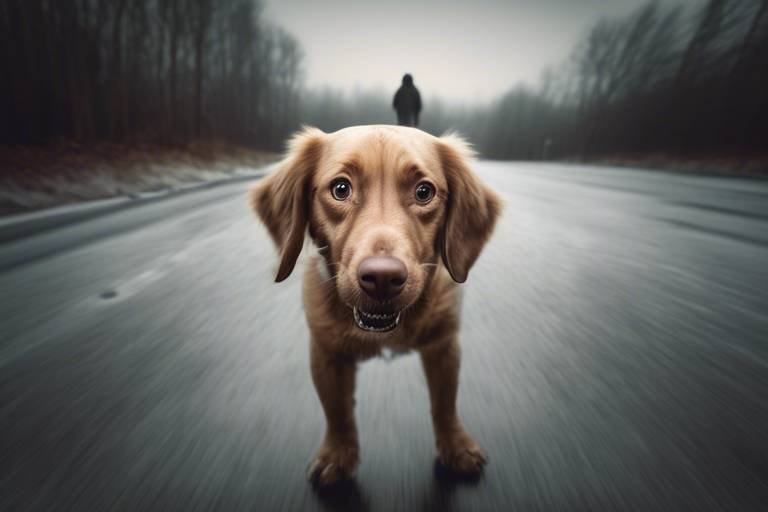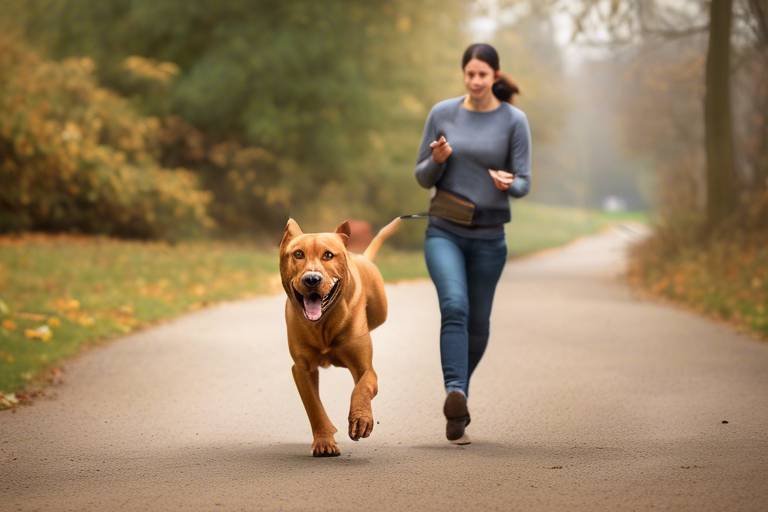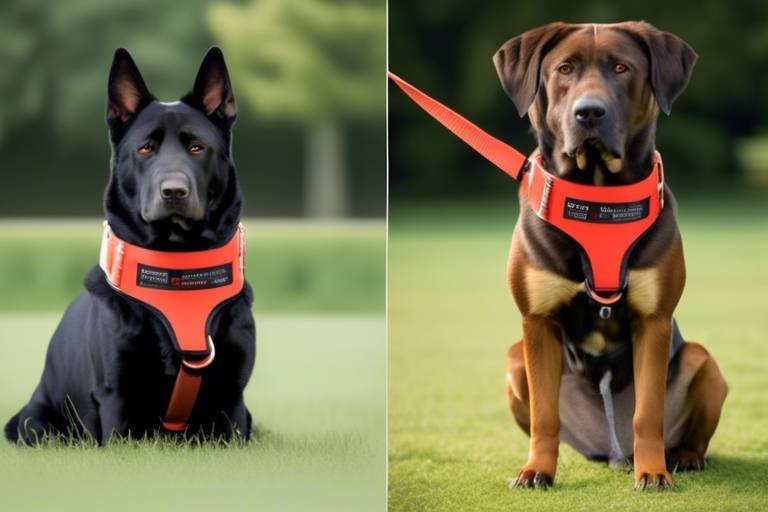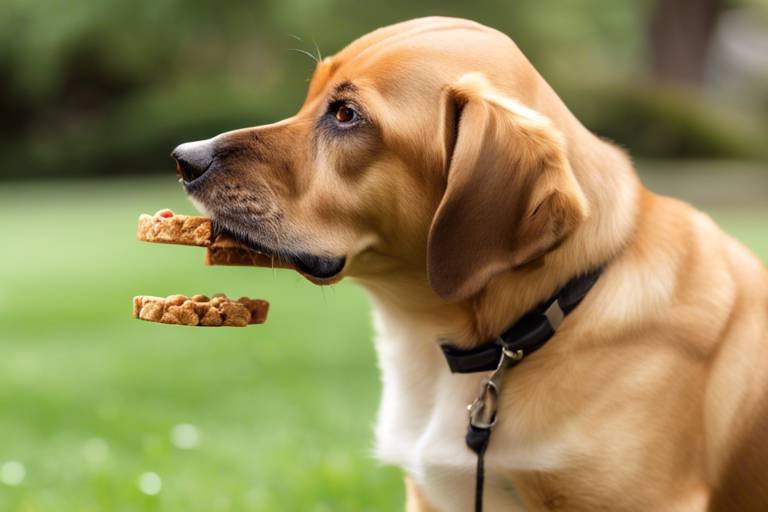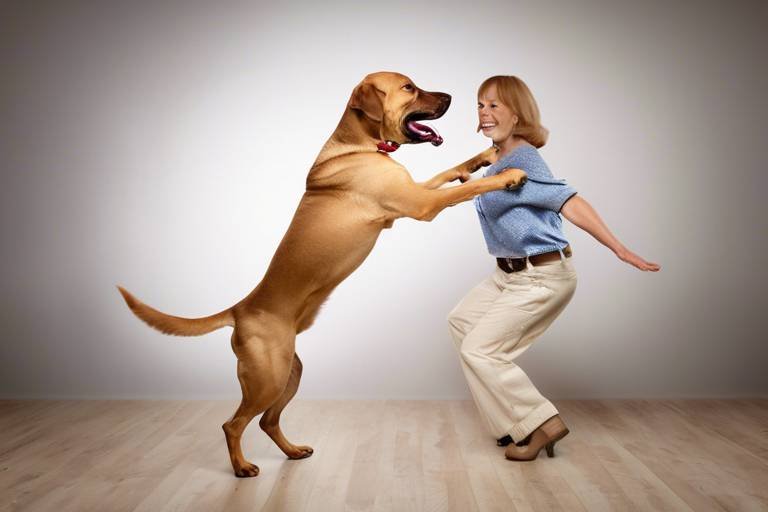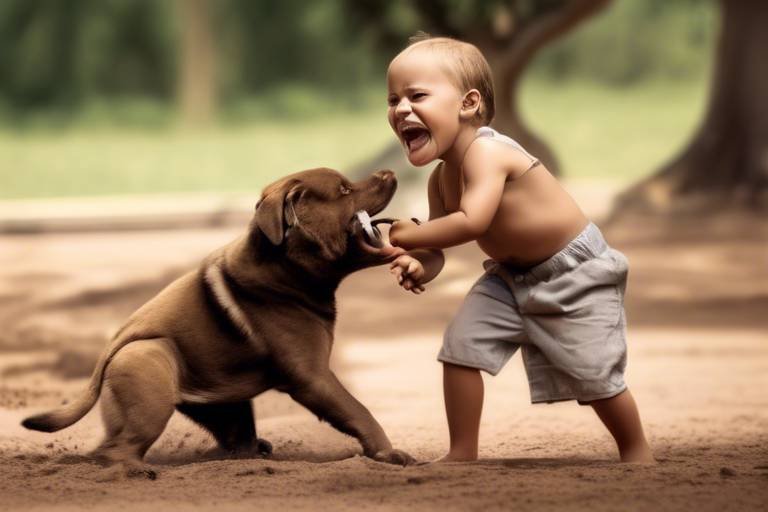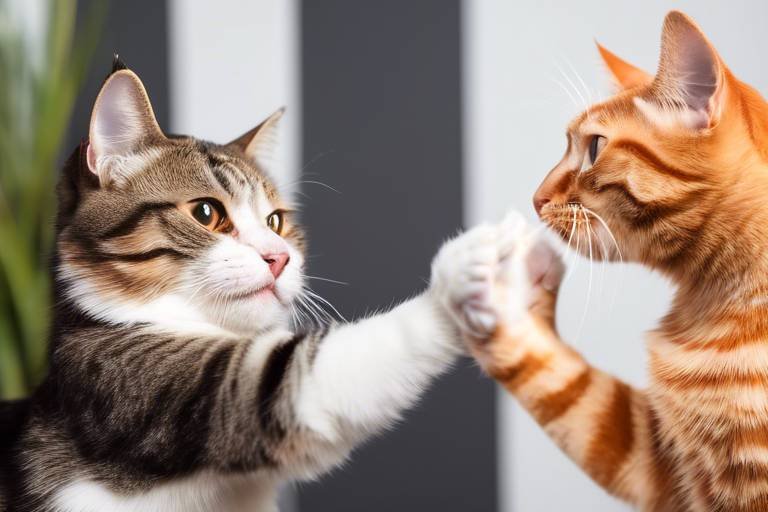How to Help Your Dog Overcome Fear of the Unknown
Every dog owner knows that our furry friends can sometimes be a bit skittish, especially when faced with new experiences or environments. Does your pup hide behind the couch during thunderstorms or bark at the mailbox when it arrives? If so, you're not alone! Many dogs experience fear of the unknown, which can lead to anxiety and stress for both the pet and the owner. The good news is that there are effective strategies you can implement to help your dog manage these fears and build their confidence. In this article, we will explore various techniques and tips that can transform your anxious dog into a more secure and self-assured companion.
Understanding the root of your dog's fear is the first step toward helping them overcome it. Canine fear can stem from various factors, including past traumatic experiences, lack of socialization, or even genetics. Being attuned to your dog's body language and recognizing signs of anxiety, such as whining, trembling, or excessive barking, is crucial. By identifying the triggers that cause your dog to feel uneasy, you can begin to address these fears in a constructive manner.
Creating a safe and comforting environment at home can significantly reduce your dog's anxiety levels. Think of your home as a sanctuary where your dog can retreat to feel secure. You can designate a specific area in your house as a 'safe space'—a cozy corner with their favorite blanket, toys, and perhaps even a piece of your clothing that carries your scent. This will give your dog a place to go when they feel overwhelmed. Additionally, incorporating calming products, such as pheromone diffusers or anxiety wraps, can also help soothe their nerves. These products mimic natural calming scents or provide gentle pressure, similar to a hug, which can be very comforting for anxious dogs.
Establishing a routine is another effective way to help your dog feel more secure. Dogs thrive on predictability, and having a consistent schedule for feeding, walks, and playtime can provide them with a sense of stability. Imagine if you didn’t know when your next meal would be or when it was time to go outside; it would be stressful! By maintaining a daily routine, you can help alleviate some of the anxiety your dog may feel about the unknown.
Gradual desensitization is a powerful technique that involves exposing your dog to fear-inducing stimuli in a controlled and safe manner. For instance, if your dog is afraid of loud noises, you might start by playing recordings of those sounds at a low volume while providing treats and praise. Over time, as your dog becomes more comfortable, you can gradually increase the volume. This slow exposure helps your dog associate the previously frightening stimuli with positive experiences, ultimately reducing their fear.
Positive reinforcement training is another fantastic way to build your dog's confidence. By rewarding your dog for brave behaviors, you create positive associations with situations that previously caused them fear. For example, if your dog approaches a new person or object, shower them with treats and praise! This encourages them to face their fears rather than retreat from them. Incorporating fun and play into your training sessions can also be beneficial. Engaging in enjoyable activities not only distracts your dog from their anxieties but also strengthens your bond, making them feel more secure in your presence.
Sometimes, despite our best efforts, a dog's fear can be overwhelming. In such cases, it may be necessary to seek professional help. A certified dog trainer or a veterinary behaviorist can provide valuable insights and tailored strategies to address your dog's specific fears. Remember, seeking help is not a sign of failure; it's a proactive step towards ensuring your dog’s wellbeing and happiness.
- What are common signs of fear in dogs?
Common signs include trembling, barking, hiding, excessive drooling, and attempts to escape.
- How long does it take for a dog to overcome fear?
The time it takes varies by dog and the severity of their fear. Some may improve in weeks, while others may take months.
- Can medication help with my dog's anxiety?
Yes, in some cases, medication prescribed by a veterinarian can be beneficial in conjunction with behavioral training.

Understanding Canine Fear
Fear is a complex emotion, and just like us, our furry friends experience it in various forms. Understanding canine fear is essential for any dog owner who wants to help their pet navigate the world with confidence. But what exactly triggers fear in dogs? It can stem from a variety of sources, including past traumatic experiences, lack of socialization, or even genetic predispositions. For instance, a dog that has been abandoned or mistreated may develop a fear of strangers or loud noises, while a puppy that hasn’t been properly exposed to different environments may be anxious in new situations.
Recognizing the signs of fear is equally important. Dogs communicate their discomfort in ways that can sometimes be subtle. Common signs include:
- Excessive barking or growling
- Shaking or trembling
- Hiding or seeking shelter
- Excessive licking or chewing
- Tail tucking or body stiffening
Understanding these signals can help you identify when your dog is feeling anxious or fearful. It's like being a detective in your own home, piecing together the clues your dog gives you. Once you can recognize these signs, you can start to address the underlying causes of their fear.
Moreover, the psychology behind canine fear is fascinating. Dogs, much like humans, have a fight-or-flight response. When faced with something they perceive as a threat, their bodies react instinctively. This response can lead to behaviors that might seem puzzling to us. For instance, a dog may choose to run away rather than confront what frightens them. Understanding this instinctual behavior is crucial in helping your dog feel safe and secure.
In addition, fear can manifest in different ways depending on the individual dog's personality and experiences. Some dogs may become aggressive when scared, while others may simply withdraw. This variability means that each dog requires a tailored approach to help them overcome their fears. It’s essential to remember that what works for one dog may not work for another, and patience is key in this journey.
By gaining a deeper understanding of your dog's fears, you can take the first step towards helping them overcome these challenges. Whether it’s through creating a safe environment, using calming products, or implementing training techniques, being informed is the best way to support your furry friend. Remember, the goal is to equip your dog with the tools they need to navigate the world confidently, turning their fears into courage.
- What are the common signs of fear in dogs? Common signs include excessive barking, shaking, hiding, and tail tucking.
- Can fear in dogs be hereditary? Yes, some dogs may have a genetic predisposition to anxiety and fearfulness.
- How can I help my dog feel more secure? Creating a safe environment and establishing a consistent routine can significantly help.
- When should I consider seeking professional help for my dog's fear? If your dog's fear is overwhelming or leads to aggressive behavior, it's a good idea to consult a professional trainer or a veterinarian.

Creating a Safe Environment
Creating a safe environment for your dog is one of the most effective ways to help them manage their fears. Just like humans, dogs thrive in settings where they feel secure and comfortable. Imagine how you would feel if you were constantly surrounded by chaos and uncertainty; it would be hard to relax, right? The same goes for our furry friends. By establishing a sanctuary within your home, you can significantly reduce their anxiety levels and help them feel at ease.
First and foremost, consider the layout of your home. Dogs are naturally inclined to seek out cozy spots where they can retreat and feel protected. This could be a quiet corner in the living room or a designated area in your bedroom. You can enhance these spaces by adding soft bedding, familiar toys, and even a piece of your clothing. These elements can provide comfort and a sense of familiarity, making it easier for your dog to relax.
Designating specific areas in your home as safe spaces is essential. Think of these spaces as your dog's personal hideaway, where they can escape the hustle and bustle of daily life. To create these areas, consider the following:
- Choose a quiet location away from high traffic areas.
- Provide soft bedding that feels comfortable and inviting.
- Include favorite toys or blankets that smell like you.
These safe spaces can be especially beneficial during stressful events like thunderstorms or fireworks. When your dog knows they have a retreat to go to, it can help them feel less anxious and more secure.
In addition to creating safe spaces, you might want to explore calming products that can help soothe your dog. There are various options available on the market, from pheromone diffusers to anxiety wraps. Pheromone diffusers release calming scents that can help alleviate anxiety, while anxiety wraps provide gentle pressure that mimics the feeling of being held, which can be comforting for some dogs. Integrating these products into your dog's routine can create a more peaceful environment overall.
Another critical aspect of creating a safe environment is establishing a routine. Dogs are creatures of habit, and a predictable schedule can provide them with a sense of security. Try to maintain consistency in daily activities, such as feeding times, walks, and playtime. When your dog knows what to expect, it can significantly reduce their anxiety levels. Think of it as a comforting rhythm in their day-to-day life, much like how we find comfort in our morning coffee or evening routines.
In conclusion, creating a safe environment for your dog involves thoughtful planning and consideration of their needs. By providing cozy retreat areas, utilizing calming products, and establishing a consistent routine, you can help your furry friend feel more secure and confident. Remember, a happy dog is a confident dog, and with your support, they can learn to navigate the unknown with ease.
Q: How can I tell if my dog is anxious?
A: Signs of anxiety in dogs can include excessive barking, pacing, hiding, or destructive behavior. If your dog exhibits these signs, it may be time to implement some of the strategies discussed above.
Q: Can I use calming products with my dog?
A: Yes, many calming products are safe for dogs. However, it's always best to consult with your veterinarian before introducing new products to ensure they are suitable for your pet.
Q: How long will it take for my dog to feel more secure?
A: Every dog is different, and the time it takes for them to feel secure can vary. Patience and consistency are key. With the right environment and support, many dogs show improvement within a few weeks.
Safe Spaces and Retreat Areas
Creating a haven for your dog is essential when it comes to helping them overcome their fears. Just like humans, dogs need a place where they can retreat and feel secure. Imagine having a cozy nook where you can escape the chaos of the world; that’s exactly what your dog needs. A safe space can be a designated corner of your living room, a quiet room, or even a crate that’s been transformed into a comforting den. The key is to ensure that this area is easily accessible and free from disturbances, allowing your furry friend to recharge when anxiety strikes.
To set up a perfect retreat for your dog, consider incorporating elements that promote relaxation and comfort. Here are some tips:
- Cozy Bedding: Invest in a soft, plush bed that your dog can snuggle into. This should be a spot where they feel completely at ease.
- Familiar Items: Include their favorite toys or a blanket that smells like you. Familiar scents can provide a sense of security.
- Calm Lighting: If possible, place the safe space in a dimly lit area of your home. Soft lighting can help reduce anxiety levels.
In addition to physical comfort, consider the location of the retreat area. It should be away from the hustle and bustle of daily life, such as noisy appliances or high-traffic areas. If your home has multiple floors, a quiet corner on the upper level can be ideal. Also, ensure that the space is well-ventilated, as fresh air can have a calming effect.
Another effective strategy is to create a “safe zone” within your yard if you have one. This can be a small, fenced-off area where your dog can explore without the overwhelming distractions of the outside world. You can introduce them to this space gradually, allowing them to associate it with positive experiences, such as playtime or treats.
It’s also important to note that some dogs may prefer to seek out their own safe spaces. Pay attention to where your dog naturally gravitates during stressful situations. If they curl up under a table or hide in a closet, consider enhancing these areas with cozy bedding or familiar items. This not only respects their instincts but also fosters a sense of autonomy and comfort.
Remember, the goal is to create a space that feels like a sanctuary for your dog. A well-established retreat area can significantly reduce anxiety and help your dog feel more secure in their environment. By providing a safe haven, you're giving them the tools they need to cope with the unknown and ultimately build their confidence.
1. How can I tell if my dog needs a safe space?
If your dog exhibits signs of anxiety, such as excessive barking, pacing, or hiding, it may be time to create a safe space. Look for behaviors that indicate they are overwhelmed or scared.
2. Can I use a crate as a safe space?
Absolutely! A crate can serve as a wonderful safe haven for dogs, provided it is introduced positively. Make sure it’s a comfortable and inviting space for them.
3. How long should I encourage my dog to stay in their safe space?
Allow your dog to stay in their safe space as long as they need. Some dogs may only require a few minutes, while others might prefer to retreat for longer periods. Always respect their comfort level.
Using Calming Products
When it comes to helping your dog manage their fear and anxiety, calming products can be a game changer. These products are designed to soothe your furry friend during stressful situations, making them feel more secure and relaxed. There are several types of calming products available, each with its own unique benefits. For instance, you might consider using pheromone diffusers, which release synthetic versions of the calming pheromones that mother dogs produce to comfort their puppies. This can create a sense of safety and familiarity for your dog, especially in unfamiliar environments.
Another popular option is anxiety wraps, which are snug garments that apply gentle pressure to your dog's body. This sensation can be incredibly calming, similar to how a hug makes us feel safe and secure. Many pet owners have reported significant improvements in their dogs' anxiety levels when using these wraps, particularly during thunderstorms or fireworks. It's like giving your dog a comforting embrace that lasts all night long!
In addition to pheromone diffusers and anxiety wraps, there are also calming treats and supplements available. These often contain natural ingredients such as chamomile, valerian root, or L-theanine, which can help promote relaxation without causing drowsiness. When selecting calming treats, it's essential to consult with your veterinarian to ensure they are appropriate for your dog's specific needs and health conditions.
To help you navigate the wide variety of calming products available, here’s a quick comparison table:
| Calming Product | Benefits | Considerations |
|---|---|---|
| Pheromone Diffusers | Creates a calming environment | Needs to be plugged in; effectiveness may vary |
| Anxiety Wraps | Provides gentle pressure for comfort | Proper fit is crucial for effectiveness |
| Calming Treats | Natural ingredients promote relaxation | Consult vet for suitability and dosage |
Integrating these calming products into your dog's routine can significantly enhance their ability to cope with fear-inducing situations. However, it's important to remember that while these products can be beneficial, they work best when combined with other strategies, such as creating a safe environment and providing positive reinforcement. Think of it as building a toolkit for your dog's emotional well-being, where each tool plays a vital role in helping them face the world with confidence.
Establishing Routine and Consistency
Establishing a consistent routine for your dog is akin to providing a sturdy backbone to their daily life. Just like humans, dogs thrive on predictability. A well-structured daily schedule can significantly ease anxiety and help your furry friend feel more secure in their environment. Think of it this way: if your dog knows what to expect and when, they’re less likely to feel overwhelmed by the unknown.
Imagine waking up every day with no idea of what comes next—wouldn’t that be a bit unsettling? The same goes for your canine companion. By establishing a routine, you’re essentially creating a roadmap for their day. This roadmap includes regular feeding times, walks, play sessions, and training. Each of these activities contributes to a sense of stability in your dog’s life, which can mitigate their fears.
To help you get started with creating a routine, consider the following components:
- Feeding Times: Set specific times for meals. Dogs are creatures of habit, and knowing when to expect food can reduce anxiety.
- Exercise Schedule: Regular walks and playtime are essential. Not only do they provide physical activity, but they also offer mental stimulation.
- Training Sessions: Incorporate short training sessions into your routine. This not only helps with behavior but also builds confidence.
- Downtime: Ensure there’s a time for relaxation. Dogs need moments to recharge, especially after a busy day.
It's crucial to maintain consistency in these activities. For instance, if you decide that feeding happens at 7 AM, try to stick to that time every day. The same goes for walks and playtime. Over time, your dog will learn to anticipate these activities, which can create a calming effect. They’ll feel more at ease knowing that their needs are being met regularly.
Additionally, consider using visual aids to help your dog understand the routine better. You might create a simple schedule chart that outlines the day’s activities. This can be especially helpful for dogs that are more visual learners. You could even use different colors or images to represent different activities. While it may sound a bit silly, dogs can pick up on cues and associate them with specific events, which reinforces their understanding of the routine.
In moments of anxiety, having a predictable routine can act as an anchor for your dog. If they know that after their afternoon walk, they will have some quiet time with you, they may be less likely to panic when faced with something unfamiliar. Over time, this structure helps your dog build resilience against fear-inducing situations.
Remember, the key to a successful routine is not just consistency but also flexibility. Life can throw curveballs, and sometimes schedules need to be adjusted. If you find that a particular time isn’t working for your dog, don’t hesitate to make changes. The goal is to create an environment where your dog feels safe and secure, and that sometimes means adapting to their needs.
Gradual Desensitization Techniques
Gradual desensitization is a powerful method for helping your dog confront and overcome their fears. Imagine your dog is like a tightly wound spring; if you suddenly yank on it, it might snap back in fear. But if you gently unwind it, allowing it to stretch and adapt, it can become more relaxed and confident. This technique involves exposing your dog to the fear-inducing stimuli in a controlled manner, starting from a distance or at a low intensity, and gradually increasing exposure as your dog becomes more comfortable.
To implement gradual desensitization, begin by identifying the specific triggers that cause fear in your dog. These could range from loud noises, new people, or even unfamiliar environments. Once you’ve pinpointed these triggers, you can create a structured plan to expose your dog to them slowly. For example, if your dog is afraid of strangers, you might start by having a friend stand at a distance where your dog can see them but not feel threatened. Over time, as your dog shows signs of comfort, you can decrease the distance between them and the stranger.
It's essential to monitor your dog's body language throughout this process. Signs of stress can include panting, cowering, or barking. If you notice any of these signs, it’s crucial to back off and give your dog a break. Remember, the goal is to create a positive association with the trigger, not to overwhelm them. Patience is key; this method may take weeks or even months, but the rewards are worth it.
Here’s a simple table to help you visualize the gradual desensitization process:
| Step | Action | Goal |
|---|---|---|
| 1 | Identify the trigger | Know what causes fear |
| 2 | Start at a distance | Ensure your dog feels safe |
| 3 | Gradually decrease distance | Increase comfort level |
| 4 | Reward calm behavior | Reinforce positive associations |
| 5 | Repeat and progress | Build confidence over time |
Incorporating positive reinforcement during this process can significantly enhance its effectiveness. Every time your dog shows calmness or bravery in the presence of the trigger, reward them with treats, praise, or their favorite toy. This not only encourages them to face their fears but also strengthens the bond you share. Just like a child learning to ride a bike, your dog needs encouragement and support to navigate their fears successfully.
As you embark on this journey of gradual desensitization, remember that every dog is unique. What works for one may not work for another. Be prepared to adjust your techniques based on your dog's responses. The key is to remain patient, consistent, and understanding. With time and effort, you can help your furry friend transform their fear into confidence, allowing them to explore the world with a wagging tail and a brave heart.

Positive Reinforcement Training
Using positive reinforcement is a powerful way to build confidence in fearful dogs. This training method is all about rewarding your furry friend for good behavior, which not only helps them learn but also boosts their self-esteem. Think of it as a way to turn fear into courage, one treat at a time! Instead of focusing on what your dog is doing wrong, you shine a spotlight on their brave moments. This shift in focus can make a world of difference.
When training a fearful dog, it’s essential to create a positive association with the things that scare them. For example, if your dog is afraid of loud noises, you can start by playing those sounds at a very low volume while rewarding them with treats and praise. Gradually increase the volume as your dog becomes more comfortable, ensuring you continue to reward their calm behavior. This technique, known as desensitization, can help your dog learn that the previously frightening stimuli are not threats.
Another effective strategy is to incorporate fun and play into your training sessions. Dogs love to play, and using games as a reward can turn a fearful experience into an enjoyable one. For instance, if your dog is hesitant to approach a new object, you can toss a favorite toy near it, encouraging them to explore while associating the object with something positive. This method not only distracts them from their fear but also reinforces their bravery.
Here are some key points to remember when utilizing positive reinforcement:
- Timing is crucial: Reward your dog immediately after they exhibit the desired behavior to create a strong connection between the action and the reward.
- Use high-value treats: Choose treats that your dog finds irresistible to keep them motivated.
- Be patient: Every dog learns at their own pace, so be prepared for gradual progress.
Incorporating these techniques can significantly enhance your dog's confidence. It’s essential to remain calm and positive during training sessions; your dog can sense your emotions. If you’re anxious or frustrated, it may only add to their fears. Instead, approach training with a sense of fun and encouragement, and you’ll be amazed at the progress your dog can make.
Lastly, remember that consistency is key. Regular training sessions will reinforce the behaviors you want to encourage. By making positive reinforcement a part of your dog's daily routine, you’ll help them feel more secure and confident over time. This approach not only builds a stronger bond between you and your pet but also transforms their understanding of the world around them.
Q: How long does it take for a fearful dog to overcome their fears?
A: The timeline varies for each dog, depending on their personality and the severity of their fear. Some may show improvement in weeks, while others may take months. Patience and consistency are essential.
Q: Can I use positive reinforcement for all types of fears?
A: Yes, positive reinforcement can be beneficial for most fears. However, if your dog exhibits severe anxiety or aggression, it may be best to consult a professional trainer or behaviorist.
Q: What if my dog doesn’t respond to treats?
A: Not all dogs are motivated by food. You can use toys, praise, or playtime as rewards instead. Find what excites your dog and use that to your advantage.
Rewarding Brave Behavior
When it comes to helping your dog overcome their fears, one of the most effective strategies is to reward brave behavior. But what does that mean exactly? Well, think of it like this: imagine you’re facing a daunting challenge, like speaking in front of a large crowd. Now, picture someone cheering you on and giving you a high-five every time you take a step forward. That’s the kind of encouragement your dog needs when they confront their fears!
To begin with, it’s essential to recognize those moments when your dog shows even the slightest hint of bravery. This could range from merely stepping closer to a scary object to actually engaging with it. Each time your dog exhibits this courageous behavior, praise them enthusiastically. Use a cheerful tone, and don’t hold back on the affection! A simple “Good boy!” or “You’re so brave!” can work wonders. Remember, dogs are very attuned to our emotions, and your positive energy will boost their confidence.
In addition to verbal praise, incorporating treats can be a game-changer. Create a small stash of their favorite snacks, and reward them immediately after they face a fear-inducing situation. This is where timing is crucial; the reward should come right after the brave act so that your dog can connect the dots between their action and the positive outcome. For example, if your dog approaches a new person without backing away, offer them a treat right then and there. This helps to reinforce the idea that facing fears leads to good things!
Moreover, you can also consider using a training clicker. This handy tool can help mark the exact moment your dog displays bravery. The click sound serves as a signal that they’ve done something right, followed by a treat. This method is not only effective but also fun for both you and your dog. It turns the training session into a game, making it more enjoyable while instilling confidence in your furry friend.
It’s also important to be mindful of the types of rewards you use. Some dogs may respond better to toys or playtime instead of treats. For instance, if your dog is particularly motivated by fetch, you could toss their favorite ball after they bravely approach something that scares them. The key is to find what excites your dog the most and use that as a reward.
Consistency is vital in this process. Make sure to reward your dog every time they display brave behavior, especially in the early stages of their training. Over time, as they become more confident, you can gradually reduce the frequency of treats, transitioning to verbal praise and affection as their primary rewards. This approach helps to maintain their motivation while ensuring they don’t become overly reliant on treats.
Finally, remember that patience is paramount. Every dog is unique, and the timeline for overcoming fear can vary significantly. Celebrate the small victories along the way and maintain a positive attitude. Your encouragement will not only help your dog face their fears but will also strengthen the bond between you two.
Q: How long does it take for a dog to overcome their fears?
A: The timeline can vary greatly depending on the individual dog and the severity of their fears. Some dogs may show improvement in a few weeks, while others may take months. Consistency and patience are key.
Q: What if my dog doesn't respond to treats?
A: Every dog is different, so it’s important to identify what motivates your dog. Some may prefer toys, playtime, or even affection as rewards. Experiment to find what works best for your furry friend!
Q: Can I use negative reinforcement to correct fearful behavior?
A: It’s generally advised to avoid negative reinforcement, as it can increase anxiety and worsen fear. Focus on positive reinforcement to build confidence and trust instead.
Q: Should I seek professional help if my dog’s fears are severe?
A: If your dog's fear is overwhelming and affecting their quality of life, it may be beneficial to consult a professional dog trainer or a veterinary behaviorist for tailored strategies.
Incorporating Fun and Play
Engaging your dog in fun activities can be a game changer when it comes to alleviating fear and anxiety. Just like humans, dogs can find comfort and joy in play, which serves as an excellent distraction from their worries. Imagine how a child forgets their fears while playing their favorite game; similarly, your dog can experience a shift in focus through interactive play. Incorporating play into your dog's routine not only promotes a sense of security but also strengthens the bond between you and your furry friend.
To effectively incorporate fun and play into your dog's life, consider the following strategies:
- Interactive Toys: Invest in toys that stimulate your dog's mind. Puzzle toys, for instance, can keep them engaged and help them forget about their fears.
- Outdoor Adventures: Take your dog on new adventures to explore different environments. This can help them gradually adjust to unfamiliar situations while having fun.
- Playdates: Socializing with other friendly dogs can boost your dog's confidence. Arrange playdates with well-behaved dogs to help them learn through positive interactions.
In addition to these activities, you might want to introduce some structured games that not only entertain but also build confidence. For example, games like fetch or hide-and-seek can be excellent ways to engage your dog while encouraging them to explore their surroundings in a safe and controlled manner. During these activities, be sure to offer plenty of praise and treats to reinforce their bravery and willingness to engage.
Moreover, don’t underestimate the power of simple activities like tug-of-war or gentle wrestling. These games can provide a physical outlet for your dog's energy and help them relax. Just remember to keep the atmosphere light and fun. If your dog seems hesitant or fearful, take a step back and allow them to approach the game at their own pace. The goal is to create a positive association with play, transforming it from a source of anxiety into a joyful experience.
Ultimately, the key to successfully incorporating fun and play into your dog's life is to pay attention to their cues. Every dog is different, and understanding what makes your dog happy will help you tailor activities that suit their personality and comfort level. By making play a regular part of your dog's routine, you can help them build confidence and learn to face their fears with a wagging tail and a happy bark.
Q: How can I tell if my dog is having fun during play?
A: Look for signs like wagging tails, playful barks, and a relaxed body posture. If your dog is engaged and seems to enjoy the activity, they're likely having fun!
Q: What if my dog doesn't seem interested in play?
A: If your dog is hesitant, try different types of activities to see what captures their interest. Some dogs prefer interactive toys, while others may enjoy outdoor exploration or socializing with other dogs.
Q: Can play help reduce my dog's anxiety over time?
A: Absolutely! Regular play can help build confidence in fearful dogs, creating positive associations and gradually reducing their anxiety when faced with new situations.

Seeking Professional Help
Sometimes, despite our best efforts, a dog's fear can become overwhelming, leaving both the pet and owner feeling frustrated and helpless. If you find that your furry friend is still struggling with anxiety and fear after trying various home strategies, it may be time to seek professional help. This decision can be a game-changer, opening up new avenues for support and guidance tailored to your dog's unique needs.
When considering professional assistance, it’s essential to understand the types of professionals available. Each has a different approach and expertise, which can be beneficial depending on your dog’s specific situation. Here’s a brief overview of the types of professionals you might consult:
| Professional Type | Description |
|---|---|
| Veterinarian | A vet can rule out any medical issues that may be contributing to your dog's anxiety and may recommend medications if necessary. |
| Certified Dog Trainer | Trainers can provide behavior modification techniques and training strategies that are effective for fearful dogs. |
| Animal Behaviorist | Behaviorists specialize in understanding the underlying causes of fear and can develop a comprehensive behavior modification plan. |
| Veterinary Behaviorist | A veterinary behaviorist combines knowledge of veterinary medicine and animal behavior, offering a holistic approach to treatment. |
Consulting with a professional not only provides you with expert advice but also reassures you that you’re not alone in this journey. It’s crucial to find someone who understands canine behavior and can tailor their approach to fit your dog’s specific fears. For example, a certified dog trainer may work with you to create a structured training plan that incorporates positive reinforcement, while a veterinary behaviorist might suggest a combination of behavior modification techniques and medication if necessary.
Moreover, during your sessions, it’s essential to communicate openly about your dog’s behaviors, triggers, and any changes you’ve noticed. This information will help the professional develop a clearer picture of your dog’s anxiety and create a targeted plan. Don’t hesitate to ask questions or express your concerns; after all, you are your dog's best advocate!
In some cases, group classes or socialization sessions may also be beneficial. These settings allow your dog to interact with other dogs in a controlled environment, which can help reduce fear over time. Just remember, every dog is different, and what works for one may not work for another. Patience and consistency are key.
Ultimately, seeking professional help can be a significant step toward helping your dog overcome their fears. With the right guidance, you can foster a more confident and secure pet, turning those anxious moments into opportunities for growth and bonding.
- How do I know if my dog needs professional help? If your dog shows persistent signs of fear or anxiety despite your efforts, it may be time to consult a professional.
- Can medication help my fearful dog? Yes, in some cases, a veterinarian may prescribe medication to help manage anxiety, especially if it severely impacts your dog's quality of life.
- What should I look for in a dog trainer or behaviorist? Look for professionals with certifications, positive reviews, and a clear understanding of fear-based behaviors.
Frequently Asked Questions
- What are the common signs of fear in dogs?
Dogs can show fear in various ways. Common signs include trembling, hiding, excessive barking, and even aggression. If your dog is cowering, has a tucked tail, or avoids eye contact, these are all indicators that they might be feeling anxious or scared. Just like us, dogs can have their own unique ways of expressing fear, so it's essential to pay attention to their body language.
- How can I create a safe space for my dog?
Creating a safe space for your dog is all about comfort and security. Choose a quiet area in your home where your dog can retreat when feeling anxious. Equip this space with cozy bedding, their favorite toys, and items that smell like you. It’s like making a personal fortress where they can feel safe and relax. Remember, the goal is to make it a go-to spot for them during stressful times.
- What calming products are effective for anxious dogs?
There are several calming products that can help soothe your fearful dog. Options include pheromone diffusers, calming collars, and anxiety wraps. These products work by mimicking natural calming scents or providing gentle pressure, similar to a hug. Think of it as giving your dog a warm, comforting blanket that helps them feel secure.
- How does routine help my dog with anxiety?
Establishing a consistent routine can greatly benefit anxious dogs. By having a predictable schedule for feeding, walks, and playtime, you’re essentially providing them with a sense of structure and security. It’s like giving them a roadmap for their day, which can help reduce uncertainty and anxiety. Dogs thrive on routine, and it can make them feel more at ease.
- What is gradual desensitization, and how do I do it?
Gradual desensitization is a technique that involves slowly exposing your dog to the things they fear in a controlled way. Start with low-level exposure—something that doesn’t trigger a full-blown panic—and gradually increase the intensity as your dog becomes more comfortable. It’s like dipping your toes in the water before taking the plunge. Patience is key, and always reward your dog for their bravery!
- How can I use positive reinforcement to help my dog?
Positive reinforcement is a fantastic way to build your dog's confidence. Whenever your dog shows bravery or remains calm in a scary situation, reward them with treats, praise, or playtime. It's all about creating positive associations with their fears. Think of it as throwing a mini celebration every time they face something that makes them anxious!
- When should I seek professional help for my dog's fear?
If your dog's fear is severe and affecting their quality of life, it's time to seek professional help. This could mean consulting a veterinarian, a certified dog trainer, or a behaviorist. They can provide tailored strategies and support that can make a big difference. Remember, asking for help is a sign of strength, not weakness!

